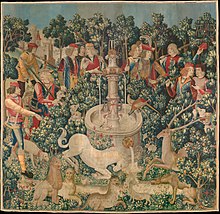Master of the unicorn hunt
An artist of the late 15th century is named as the master of the unicorn hunt ( French: Maître de la Chasse à la Licorne ) or the master of the New York unicorn hunt . The artist , who is not known by name , designed the seven tapestries depicting a hunt for the unicorn around 1480 or 1500 , which are now in New York in the Metropolitan Museum of Art The Cloisters .
History of the manufacture and ownership of New York carpets
The magnificently decorated tapestries of the unicorn hunt are probably of Brabant origin and were probably made in the center of tapestry production around 1500 in Brussels , the Netherlands , but because of their history of ownership and the fashion shown in the pictures, the designs of the carpets can still be regarded as the work of a French master become. They are first recorded in 1680 in the possession of the Duc François VI de La Rochefoucauld, it is believed that they go back to a purchase before 1516 by Comte François I de La Rochefoucauld . After that, the carpets appear in a list from La Rochefoucauld Castle (Château de Verteuil) in Verteuil from 1728. The carpets, rediscovered after the French Revolution around 1850, have been in the New York Museum The Cloisters as a gift from John D. Rockefeller since 1937 .
Scenes of the seven unicorn carpets
The carpet sequence of the unicorn hunt is reminiscent of the medieval stag hunt, both religiously (for example with christological symbols such as the unicorn as Christ) and secularly interpretable sequence of scenes with over a hundred plant species and various animals (such as the ermine , which is protected from poison by the pleasure of wine rue ):
- Start of the hunt
- Unicorn at the fountain
- The unicorn is jumping over a stream
- The unicorn defends
- The unicorn captured by the virgin (fragment or draft)
- Killing the unicorn and transporting it to the castle
- alternate scene: captivity of the unicorn
Other works
In the history of art, it is suggested that the master of the unicorn hunt should be assigned further designs and book illustrations by comparing styles; it is also suggested to equate him with the master of the Apocalypsenrosis , a book and glass painter who designed and created glass windows in Paris. However, such assumptions remain speculative due to the lack of precise documents on works. However, they shed light on the lively exchange of new ideas and techniques in artist workshops in France in the early modern period.
Stylistic influences
The unicorn hunt master may have been a disciple of the Coëtivy master .
literature
- Margaret B. Freeman: The Unicorn Tapestries (Metropolitan Museum of Art). New York 1974.
- Christina Becela-Deller: Ruta graveolens L. A medicinal plant in terms of art and cultural history. (Mathematical and natural scientific dissertation Würzburg 1994) Königshausen & Neumann, Würzburg 1998 (= Würzburg medical-historical research. Volume 65). ISBN 3-8260-1667-X , pp. 206-209.
Individual evidence
- ^ G. Souchal: Un grand peintre français de la fin du 15th siècle: le maitre de la Chasse à la Licorne. Revue de l'Art 22 (1973), pp. 22-47
- ↑ so z. BAMarkschies: Review by: Ina Nettekoven: The master of the apocalypse rose . In: sehepunkte 8 (2008), No. 4 (from April 15, 2008), [1]
- ↑ English Master of the Cloisters Unicorn
- ↑ Master Of The Unicorn Hunt . In: Grove Dictionary of Art, 2000 (accessed June 2010 online)
- ↑ Christina Becela-Deller: Ruta graveolens L. A medicinal plant in terms of art and cultural history. 1998, p. 206.
- ↑ Christina Becela-Deller: Ruta graveolens L. A medicinal plant in terms of art and cultural history. 1998, pp. 206-209 and 211.
- ↑ See I. Nettekoven: The Master of the Rose of the Apocalypse of the Sainte Chapelle and Parisian Book Art around 1500 . Turnhout 2005
- ↑ // Coëtivy, Master of //. In: Grove Dictionary of Art, 2000 (online edition), accessed June 2010 (English)

